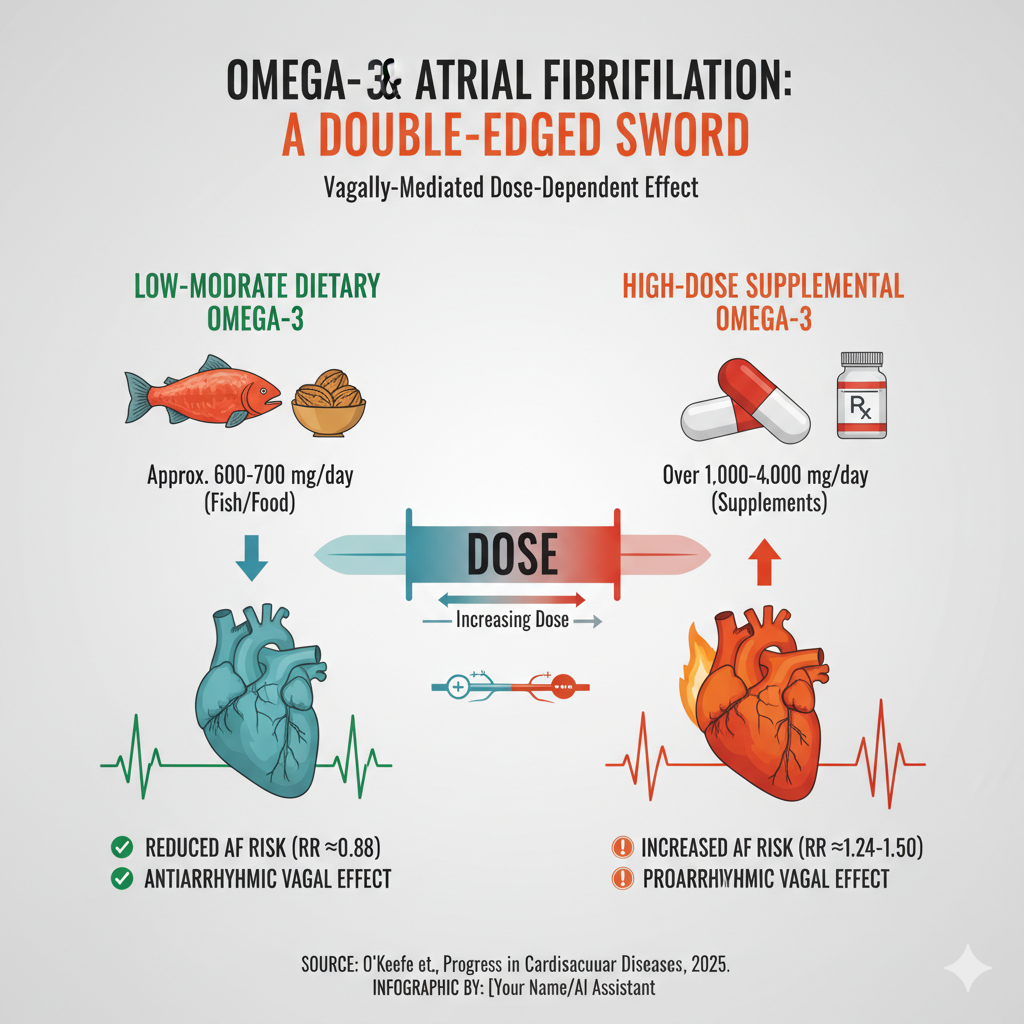
Comment:
Summary:
Clinical Bottom Line
This review presents a compelling “double-edged sword” hypothesis for the effect of omega-3 fatty acids on the risk of atrial fibrillation (AF). The key takeaway is that the dose and source matter. Low-to-moderate dietary intake of omega-3s from fish (around 600–700 mg/day) appears to be associated with a reduced risk of AF1. In stark contrast, high-dose pharmaceutical omega-3 supplements (especially those providing over 1,000 mg/day) are associated with a dose-dependent increase in AF risk. The authors propose that this paradoxical effect is mediated by omega-3’s dose-dependent influence on vagal tone.
Results
This review synthesizes findings from randomized controlled trials (RCTs), meta-analyses, and large observational studies, revealing a clear divergence in outcomes based on omega-3 dosage.
-
High-Dose Supplements Increase AF Risk: A meta-analysis of eight large RCTs involving over 83,000 patients found that pharmacologic omega-3 treatment was associated with a 24% increased relative risk of AF (RR 1.24, 95% CI 1.11-1.38). This effect was strongly dose-dependent:
-
Doses around 1,000 mg/day were associated with a modest ~12% increase in AF risk.
-
Doses between 1,800 and 4,000 mg/day were associated with a substantial ~50% increase in AF risk.
-
-
Dietary Intake and Blood Levels Associated with Lower AF Risk: In contrast to trial data on supplements, observational studies suggest a benefit from omega-3s acquired through diet.
-
A pooled analysis of 17 prospective cohort studies found that individuals with the highest blood levels of DHA+EPA had a 12% lower risk of developing AF compared to those with the lowest levels.
-
Dietary studies report a U-shaped relationship, with the maximum risk reduction (around 12-13%) occurring at a daily intake of approximately 630 to 750 mg/day.
-
Assertive Critical Appraisal
This is a narrative review that effectively synthesizes discordant evidence to generate a plausible hypothesis. However, it is not a formal systematic review and lacks the methodological rigor of one (e.g., PRISMA guidelines).
-
Certainty of Evidence: The evidence from multiple large, well-conducted RCTs showing that high-dose omega-3s increase AF risk is of High certainty. The evidence from observational studies suggesting a protective effect of dietary omega-3 is of Low to Moderate certainty due to the inherent risk of confounding (e.g., people who eat more fish may have other healthier lifestyle habits).
-
Heterogeneity: The primary finding of this review is the significant heterogeneity between studies of high-dose supplements and studies of dietary intake. The meta-analysis of RCTs itself showed significant statistical heterogeneity between the low-dose and high-dose trial subgroups (I2=88.8%), strongly supporting the authors’ dose-response hypothesis.
-
The Vagal Tone Hypothesis: The proposed mechanism—that omega-3s increase vagal tone in a dose-dependent manner—is biologically plausible. Low-level vagal stimulation can be antiarrhythmic, whereas high-level stimulation is known to be proarrhythmic and can induce AF. This elegantly explains how low dietary doses might be protective while high supplemental doses become harmful.
-
Conflicts of Interest: It is important to note that several authors have relevant financial disclosures, including roles in companies that sell omega-3 products or offer omega-3 blood testing. While this does not invalidate the findings, it provides important context.
Research Objective
The review aimed to clarify the conflicting effects of marine omega-3 (EPA and DHA) intake on the long-term risk of developing AF and to explore vagal tone as a potential biological mediator for this relationship.
Study Design
The authors conducted a literature search of PubMed to identify and summarize findings from meta-analyses, randomized controlled trials (with at least 500 participants), and prospective observational studies that investigated the link between omega-3s, AF, and autonomic (vagal) tone. The review summarizes data from 8 RCTs and 17 prospective cohort studies, covering tens of thousands of individuals.
Bibliographic Data
-
Title: Omega-3 and Risk of Atrial Fibrillation: Vagally-Mediated Double-Edged Sword
-
Authors: Evan L O’Keefe, James H O’Keefe, Hussam Abuissa, et al.
-
Journal: Progress in Cardiovascular Diseases
-
Year: 2025 (Published online 2024)
-
DOI: 10.1016/j.pcad.2024.11.003
This AI-generated analysis is for informational and research purposes only and is not a substitute for professional medical advice, diagnosis, or treatment. Always seek the advice of a qualified health provider with any questions you may have regarding a medical condition.
Original Article:
Pubmed Central: here
Full text pdf: here
